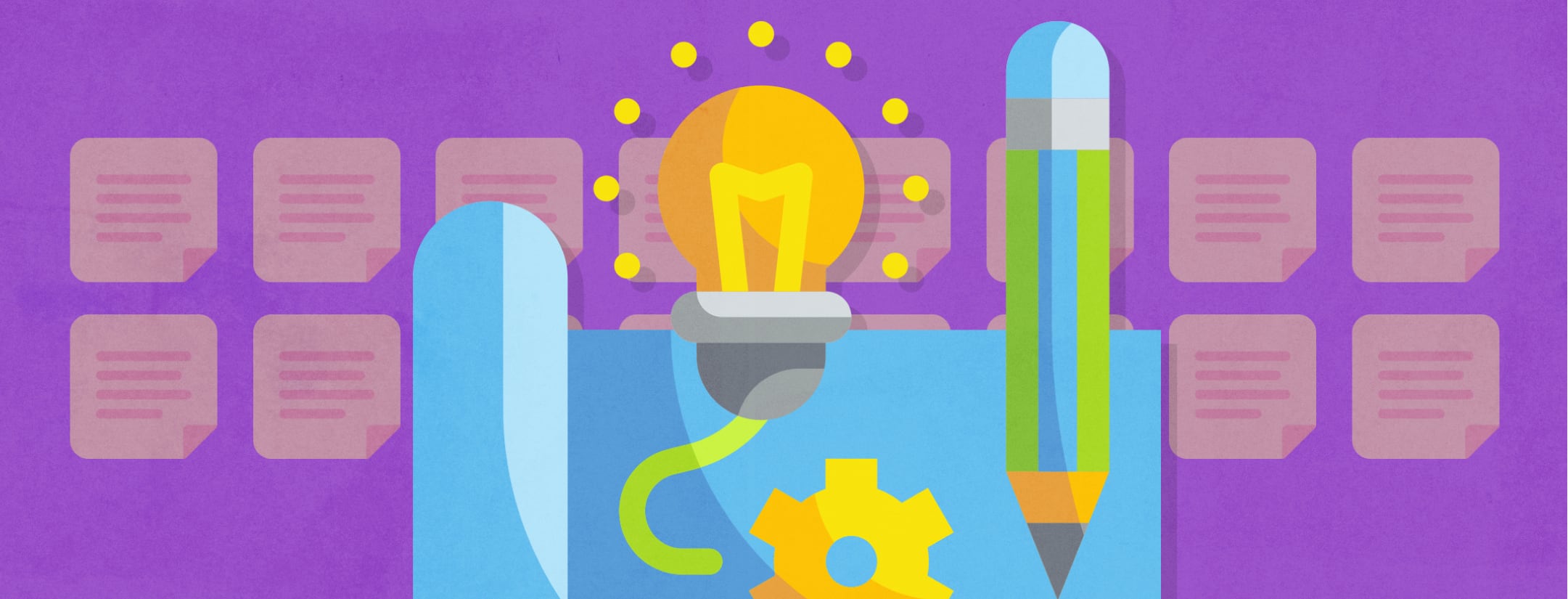
What is a Service Blueprint and How Can it Improve Customer Experience & Business Operations?
- Product Design /
- Product Discovery /
- Product Strategy /
Fulfilling the needs of your customers is critical to the success of any business. In order to do this you first must understand how your organization is being perceived. It can be challenging to monitor all of the various touch points your users experience from start to finish and take action to improve these interactions. Visualizing your customer’s journey can provide great insight into areas of improvement. But what’s the best way to do this? You could run a detailed analysis report, but these can quickly become verbose and require an exceptional amount of time and effort to assemble. In this article, we’ll look at a more efficient way to collate this kind of visualized information quickly by utilizing a service blueprint.
A service blueprint reveals the chronological actions your customers take while detailing the business operations that correspond with each action and what your business or organization needs to continue delivering an optimal customer experience. When completed, you will uncover areas of opportunity as well as friction. This information can be used to improve business operations and the customer experience simultaneously.
What is a service blueprint?
A service blueprint serves as a visualization tool, essential for mapping the entirety of a customer’s journey from initial interaction to completion when engaging with your product or service. It comprehensively documents the sequential steps customers undertake, while also delving into the behind-the-scenes processes and touchpoints required for each stage.
More specifically, a service blueprint:
- Maps the Customer Journey: Encompasses multiple service stages such as awareness, consideration, purchase, onboarding, and support.
- Captures Customer Elements: Records customer actions, emotions, and touchpoints at each stage of the journey.
- Details Frontstage Interactions: Illustrates interactions between customers and company representatives at the forefront.
- Visualizes Backstage Activities: Depicts backstage activities, including systems, processes, and employees crucial for service delivery.
- Connects Frontstage and Backstage: Establishes connections between frontstage and backstage through lines of interaction and visibility.
In essence, a service blueprint provides a comprehensive view of service delivery from the customer’s perspective. This outside-in approach facilitates the identification of pain points and optimization opportunities throughout the entire customer experience lifecycle. Utilizing this methodology enables product teams to align user needs with business operations, resulting in heightened customer satisfaction.
What does a service blueprint look like?
Before we begin, here’s a high-level example of what a single stage of a service blueprint could look like at a glance. Stages focus on the chronological (displayed horizontally from left to right) actions your customer takes in their journey towards their ultimate goal.
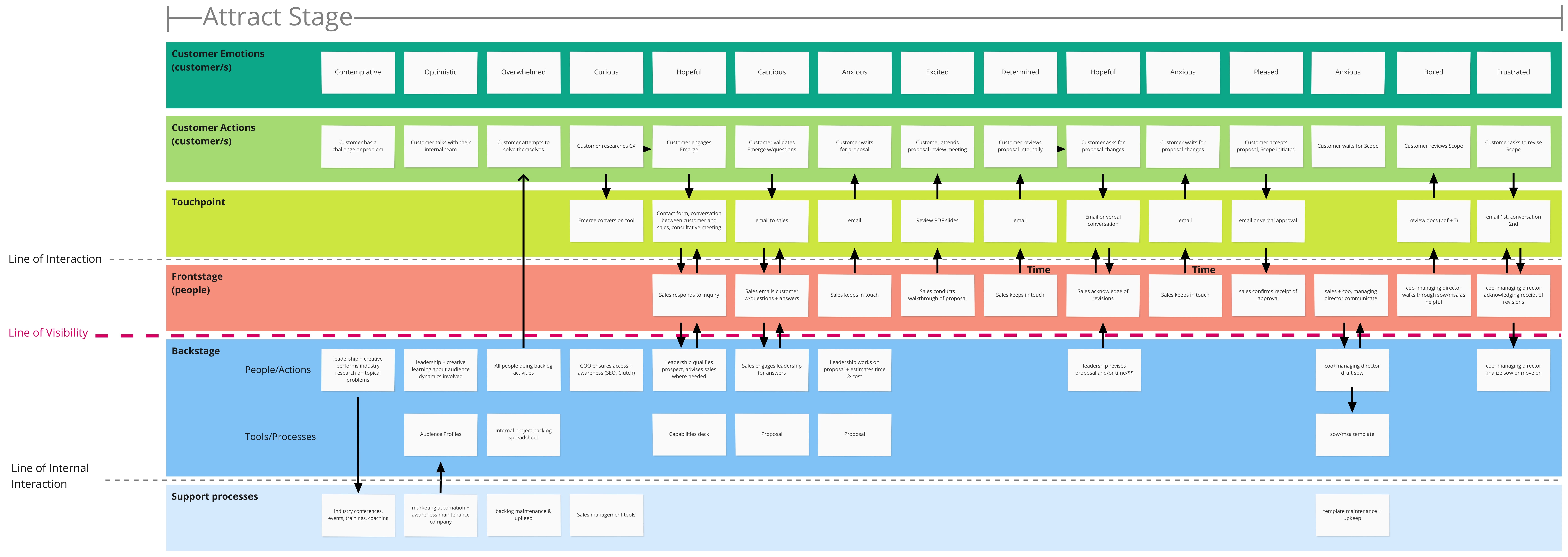
Download our example service blueprint as PDF.
The 5 Common Service Design Blueprint Stages
This can be somewhat dependent on your company’s offerings, but generally, stages follow a common pattern within most businesses or organizations:
- Attract: This stage is how the customer finds your business or organization. It may take some time for a role on your end to be identified, but this is the most critical stage of your business. Without customers, you will not have business. If you have a digital product then SEO plays a main role to attract customers for your business. If you don’t know about SEO or how to track keyword performance then you can hire a white label seo company that helps you to achieve your goal.
- Orient: Once customers have engaged with you, before the work begins, it’s time to get them ready to understand what will happen and when it will happen.
- Use: This is the “work” stage. If you like, you can subdivide this section, but put everything you do to create the solution your customer hired you for here.
- Retain: Once the solution is attained, especially if we’re talking about digital products — it will need advancement and improvement over time. The “retain” stage is where this happens.
- Maintain: Customers may move on to other things once they have their solution, but this stage is how your business or organization stays in touch and maintains the relationship with them.
It may also be helpful to consider the service blueprint stages in a similar fashion to the buyer’s journey, which is also known as the “customer path to purchase” since it directly correlates to the steps your customer takes.
What is the Buyer’s Journey?
Customers can compare your business to other similar businesses very rapidly thanks to the wealth of digital information at their fingertips. The services and/or digital products you offer are typically put under heavy scrutiny fairly quickly and thus a clear value proposition is key to understanding differentiation. This also means that you have the opportunity to earn customer trust very early in their journey, potentially even before they are aware of your competition.
The most common buyer journey stages and associated customer mind-sets are:
- Awareness: Can you help me?
- Consideration: What do you do? What insight can you provide around my challenge(s) or problem(s)?
- Sign-up: What’s different about your product offering?
- Evaluation (demonstration of the product value): Do you have direct expertise in solving my challenge? How effective is your product in solving my known and unknown needs? Are you the best value for me?
- Purchase: How much does it cost? What is the path to purchase? What are the risks of moving forward?
- Retention: What is the value provided over time?
- Referral: How can I share this product and/or my experience with others?
Why is this Relevant to a Service Blueprint?
The steps your customers take usually begin with some sort of problem or challenge they’re facing. At this point, they may or may not even be aware of your business but they likely will as they begin to perform research. To help start to fill out the service blueprint, think about what things your business does to ensure customers have a clearer understanding of who you are and what you offer, so that by the time they are aware of you they have a clear indication of whether or not they should be engaging with you to resolve their problem or challenge.
To further assist with this, we’ve created the service blueprint downloadable PDF tool below that takes the stages above and identifies the Buyer Journey steps that align with these stages. But let’s keep going so you can maximize its impact for your business.
Visualizing the Factors That Impact Your Customers
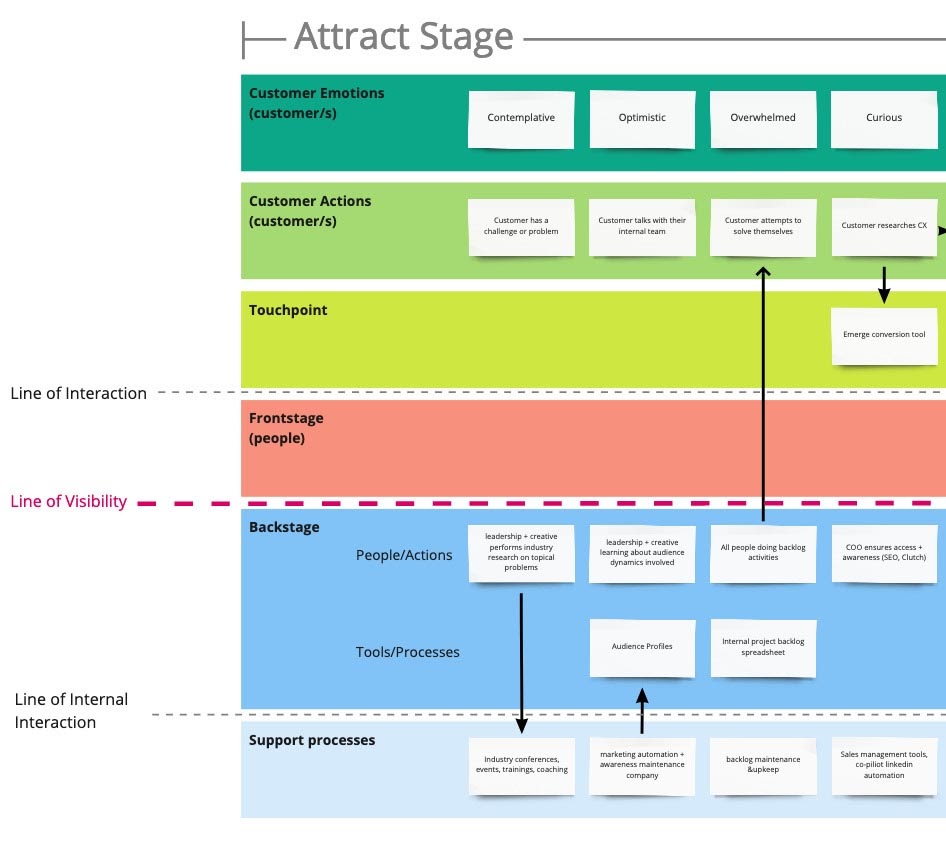
These rows are factors that directly affect your business or organization while your customer is proceeding towards their ultimate goal:
- Customer Emotions: This is what your customer is feeling during each step of their journey that leads to an action. If they have not yet engaged with your company, these feelings should be aligned with the steps you are taking in order to address these emotions and attract them to you.
- Customer Actions: These are the individual steps that your customers are taking to address their needs. As you can see above, your customers may not initially be aware of your business. This factor can be helpful in understanding the best way to position your business for visibility as your customers search for a solution.
- Touch points: These are areas of engagement with your business or organization. It may take a few steps to get here, but these become incredibly important as vehicles to getting customer information to you. Website form fields and emails are common touch points, for example.
- Line of Interaction: Everything above this line is customer specific, but once they engage with you, they cross the line of interaction.
- Frontstage: This is identifying who exactly your customers engage with on your side. At the beginning of their journey, it may take some time before a specific role becomes involved.
- Line of Visibility: This is where the customers’ visibility blends into your process.
- Backstage: This is where your business or organization comes in to service the customers at each step of their journey, identifying who is involved, and what tools or processes are involved.
- Line of Internal Interaction: This is the dividing line for employees vs the support mechanisms they require.
- Support processes: This is what allows your employees to evolve their capabilities of servicing your customers over time, such as professional development and automated services.
Arrows signify connections between individual details being collected. A one-way arrow designates a contingent factor or requirement. A two-way arrow indicates that one detail influences the other. As an example, “sales” as a role may be having back and forth conversations with the customer based on an inquiry. Once the customer is done with this conversation however, it’s up to sales to keep in touch as their customers’ journey continues.
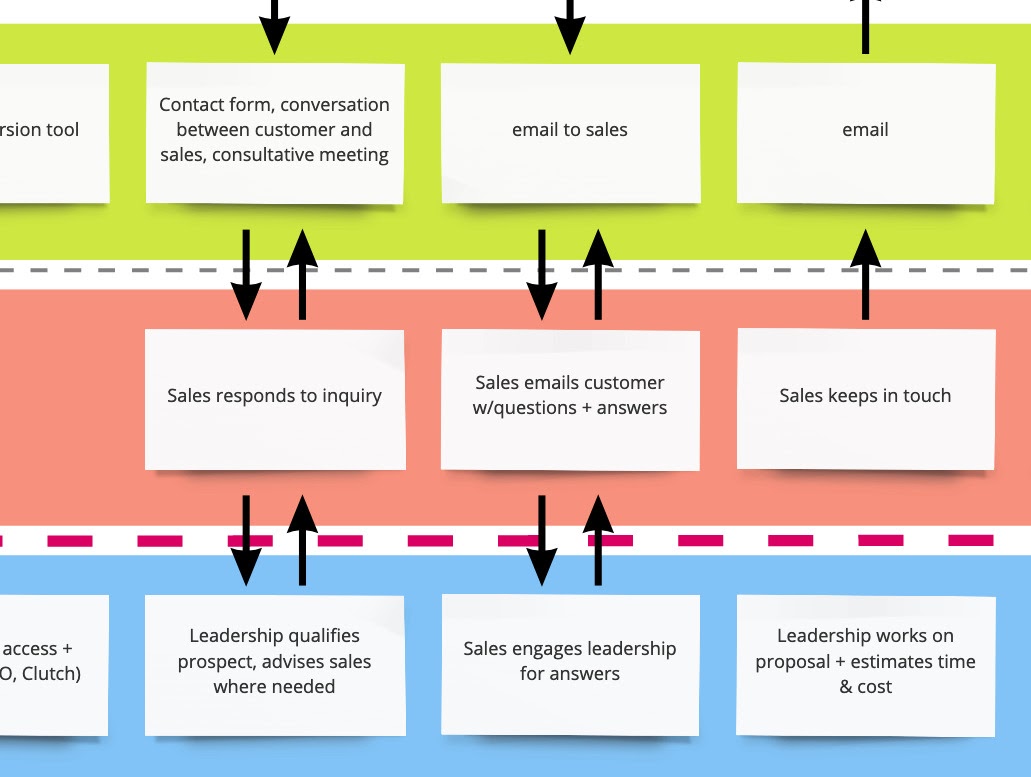
As for the medium, the above examples were translated into a cloud-based design service called Miro. You can use whichever medium you prefer (list of web design software). For those that prefer a physical manifestation, sticky notes seem to be the best vehicle. Before we digitized our service blueprint, here is what our entire service blueprint looked like on the back wall of our office space.
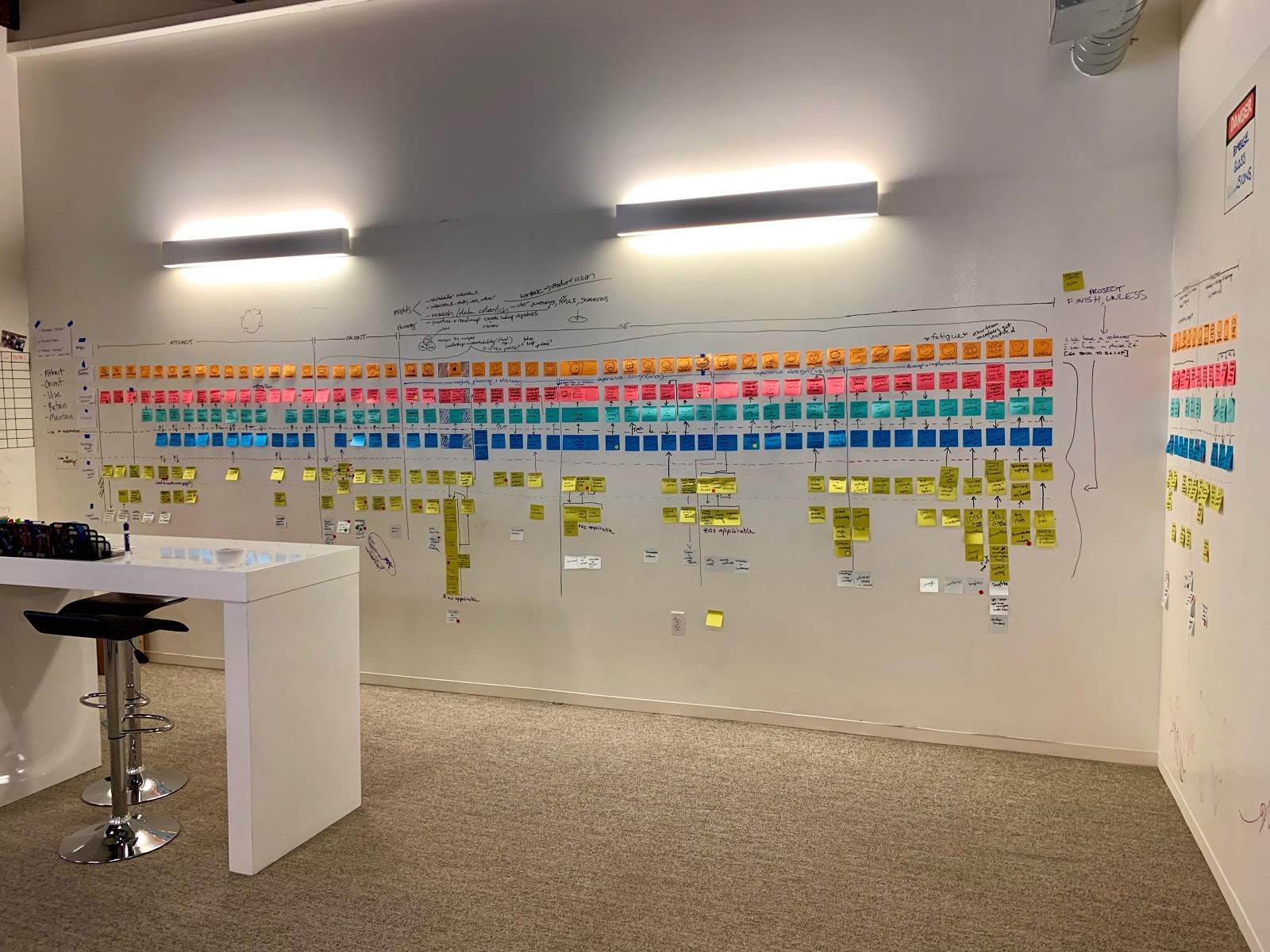
Stickies are fantastic because you can quickly reposition things as you go. This is important because your service blueprint will rapidly change until it is completed. You are discovering new things as well as connecting well-known ones.
What’s the best way to start my own service blueprint?
Now that you have an idea of what a service blueprint looks like and some of the components involved, let’s put it all together and get you going. I promise it’s easier than you might think!
- Add factor rows along the left-hand side: Since these rows will always be the same in every blueprint, line them up vertically in your physical or digital workspace. Get ready to add a lot of customer actions horizontally from here depending on how many stages you have. Make sure you have plenty of physical room or ensure your digital workspace is flexible horizontally.
- Start with the first stage applicable to your business or organization: For us, this is “attract” because we’re in the business of providing customer solutions.
- Add your customer’s first action in this stage: Think about this in relation to the offerings of your business or organization. We’re a digital product agency that creates solutions to our customers’ variable problems or challenges both physical and digital, so ours was “Customer has a problem or challenge.”
- What emotion drives this action? Keep it to one word. Ours was “contemplative”.
- Keep going, you’re doing great! Repeat steps 2 & 3 for every customer action that happens during this stage. Here are a few examples you might use:
- Customer performs research.
- Customer sends an email inquiry.
- Customer wants to consult.
- Now start adding other factors for each action your customer takes: Using the factor descriptions above, start to chart out all the other factors involved during each of your customers’ actions. Once you get going, you’ll have a lot of fun. Don’t overthink it, you can always go back and refine them. Some customer actions don’t have any factors because they might not be directly engaging with you just yet. That’s OK because we want to capture it all, as is. Here’s an example of one customer action and all of the factors involved:
- Action: Customer engages with Emerge
- Emotion: Hopeful
- Touch points: Contact form, conversation between customer and sales, consultative meeting.
- Frontstage: Sales responds to inquiry
- Backstage (People): Leadership speaks with prospect, advises sales as needed.
- Backstage (Tools): Emerge capabilities presented to customers.
- Support Process: Capability refinement & improvement.
- Add arrows to show connections where applicable.
- Finish this stage and start the next one: Each stage should have all related customer actions and any applicable factors that apply. For ours, our customers’ last action was “Customer refines scope before it is approved and signed.”
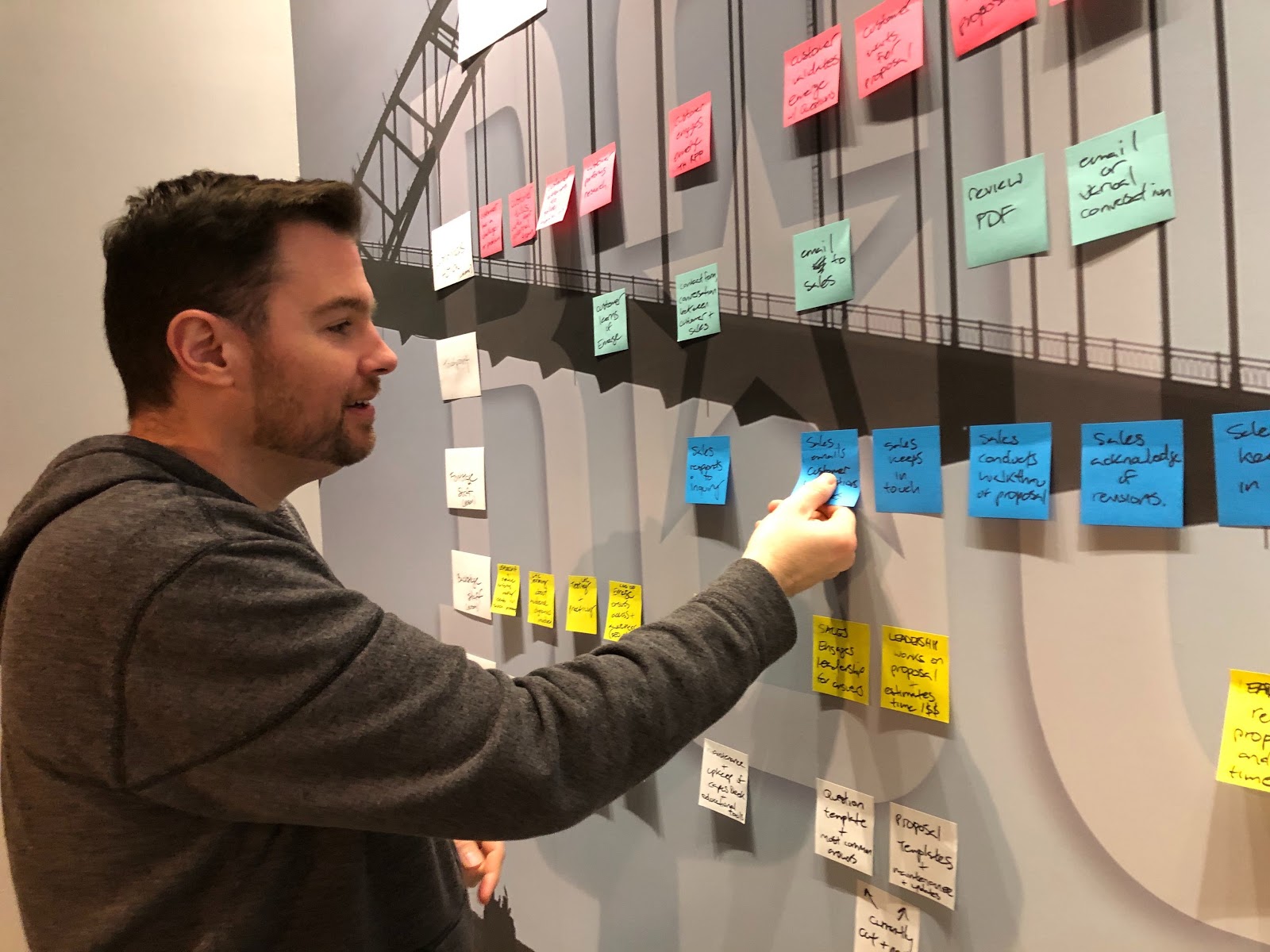
How to level up your business or organization using the service blueprint
After collecting all of this information across all of the stages your organization moves through, you can use this information to create tactical ways of addressing friction areas. You will also be able to highlight the opportunities where your business or organization excels.
Grab some sticky dots, or use circular dots in a digital forum. Use red dots for friction, green dots for opportunities, and yellow dots for cautionary items or things to watch. Number them and create a legend. Next time you have a discussion with interested parties, these become points of focus and discussion.
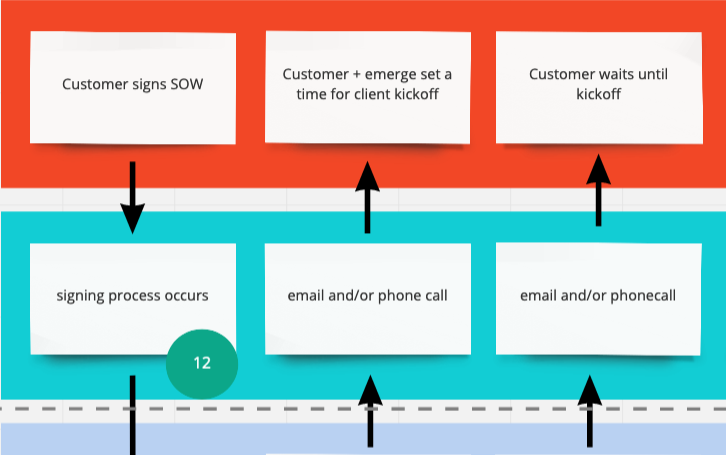
Visit the service blueprint often to make your customers’ experience a great one
The goal of this exercise is to visualize and document what’s happening along the customer journey in relation to how your business or organization delivers on each step. To truly benefit from this process, be sure to revisit this tool on a regular basis. You’ll be able to track how well you’re improving and be reminded of where friction points exist. Need help with your service blueprint? Our creative team is here for you. Reach out to us today and we’ll schedule a time to consult with you and your team.